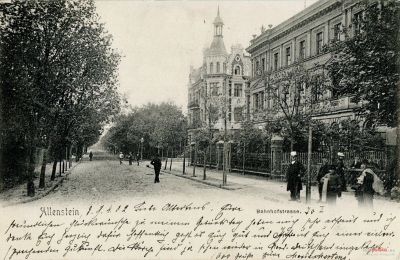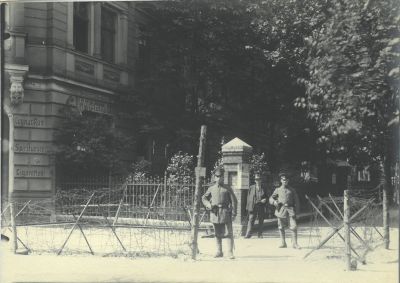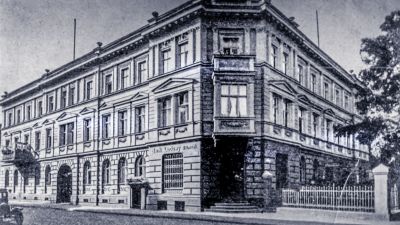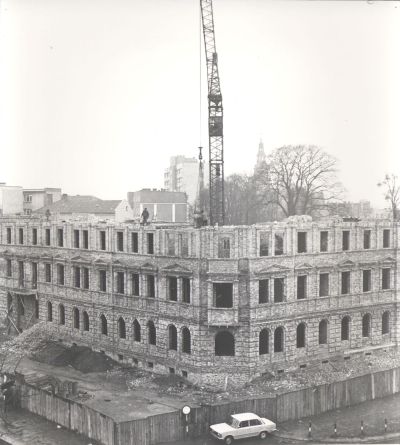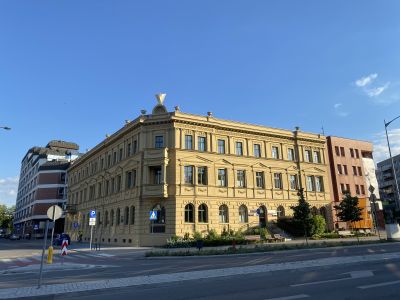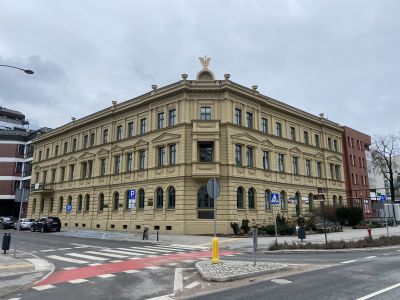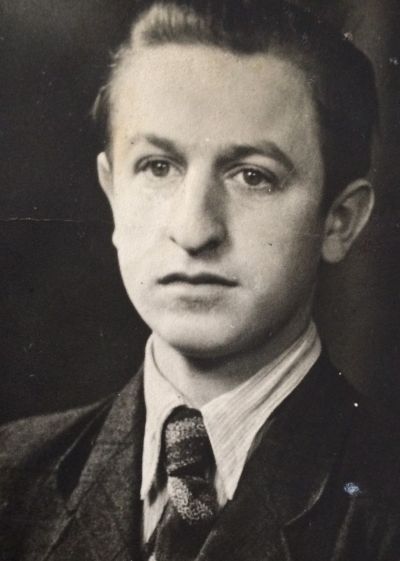Dom Polski in Allenstein / Olsztyn

Before the First World War, a series of restaurants and inns were housed in the impressive Gründerzeit building, the exterior of which has changed very little since it was built around 1885 by the entrepreneur Joachim Hosmann. In 1899, Hosmann sold the house to Otto Holzky, who opened a hotel called “Reichshof” there. In the years that followed, the building changed owner several times but the hotel, in which the Prussian General Field Marshall Albrecht of Prussia stayed the night, remained in operation, even though its name changed: In 1912, it was renamed “Central Hotel, before being changed back to “Reichshof” again a few years later.
The First World War and the enormous political, economic and social changes that went with it also manifested themselves in the garrison town, which until that time had been a quiet provincial town. The house in Bahnhofstraße was to become the focal point of German-Polish relationships, or rather the lack of them. In 1920, the building was bought by the authorities of the Second Republic of Poland that was created in 1918 and parts of the building were repurposed to become the headquarters of the Polish Plebiscite Committee. The hotel kept operating as an “international” hotel under the new owners.
On 22 June 1920, the Treaty of Versailles was adopted by the National Assembly of the newly founded Weimar Republic: According to the provisions of the Treaty, Poland – which had been divided between the German Reich, Austria-Hungary and Russia since 1795 – became an internationally recognised and independent republic to which the German Reich had to make territorial concessions. The Treaty of Versailles, which was perceived as a “dictatorial peace”, was rejected by all levels of German society. In May 1919, the left-wing politician, pacifist and anti-war protestor Hugo Haase from Olsztyn wrote:
“As an East Prussian, I would particularly like to point out the violation which has been wrought on the people of this province ... For almost 40 years, I, along with the residents of this territory that is now to be torn away from the German Reich, have never thought about a separation, never wished an association with another folk; it is simply pushed like a lifeless mass onto another state through an act of violence.”[1]
According to the treaty, referenda were supposed to be held in several border regions in order to establish the allegiance to the German Reich or its neighbours. In the province of Eastern Prussia, a referendum was established on 11 July 1920 for the southern Warmia and Masuria regions. At the beginning of 1920, British, French, Italian and Japanese (!) troops arrived in Olsztyn and took over the military command and the civilian administration. All those entitled to vote in the plebiscite had to have reached the age of 21 on 10 January 1920 and had to have been born in the voting district or had their place of residence there since 1 January 1905. People from Warmia and Masuria living outside the district were also entitled to vote. The Poles could not hope to have any great support in Masuria, but the outlook was somewhat better in the Olsztyn district. To ensure secure and fair elections, the town of Olsztyn became its own state for a while: The voting regions were under the control of two Allied Commissions made up of five members appointed by the most important allied and associated powers as representatives of the League of Nations. However, tensions had grown since the Allied Commission had arrived in the town. At the beginning of March, there was an altercation in the Polish Consulate, as the conservative German nationalist newspaper Ermländische Zeitung reported on 7 March 1920:
“Around midday, when the band of the British troops played in front of the government building in which the Allied Commission had its headquarters, a Polish flag was hoisted out of one of the windows of the Polish Consulate. As soon as it was visible, the people gathered before the Consulate; and also the people who had gathered in front of the government building to hear the concert hurried in the direction of Bahnhofstraße and joined the people in front of the Consulate. The German population now shouted: 'Lower the flag!' When nothing happened and the Consul General showed himself at the window, some of the men stormed on to the terrace of the Hotel Imperial, which was housed in the same building, tore the flag down amidst yells from the crowd and ripped it up. Then the crowd sang 'Deutschland, Deutschland über alles' and 'Heil dir im Siegerkranz'.”
The Allied Commission then removed the Mayor of Olsztyn, Georg Zülch, from office because he refused to apologise to the Polish Consulate. In the weeks leading up to the plebiscite, both sides increased their activities and the constituencies were flooded with posters and flyers, patriotic celebrations, concerts and rallies. The Polish activities were planned and coordinated from the house in Bahnhofstraße. At the same time, however, the Second Polish Republic was conducting a bloody war against the Soviet Union, so the support for the plebiscite had to take a back seat in the face of the war situation: In May 1920, the Red Army had started an offensive in the vicinity of Kiev, at the beginning of June the Polish troops were on the retreat. It did not look good for the Polish state. The closer the date for the vote got, the more hectic the situation became. On 2 July, the Ermländische Zeitung reported that a group of nationalist Germans violently entered the house in Bahnhofstraße but were beaten up there and locked in a room. A crowd of people once again gathered in front of the house and demanded that the “prisoners” be released. Soon the troops of the German Reichswehr were facing the newly formed army of the Weimar Republic and British troops with fixed bayonets. Whilst some British soldiers entered the building, the German troops threatened to put their machine guns into position. A few Poles appeared at the window and, according to the Ermländische Zeitung, called out: “You don't even have machine guns!”. The blood-covered “prisoners” were then escorted out of the building by the British. All these escalations led to the house soon being surrounded by a barbed wire barrier and guarded by military posts.
[1] Andreas Kossert: Ostpreussen, Geschichte und Mythos, p. 218
All the activities of the Polish Committee and the Polish activists aside, the result of the referendum was unequivocal: With 87 % of voters turning out, 363,209 votes (97.86 %) were for remaining in East Prussia and 7,924 (2.11 %) for forming a union with Poland. However, the building, which was now known as “Dom Polski”, or Polish House, remained a centre of Polish activities in Olsztyn and Warmia. However, these activities now transitioned from the political to the cultural. In 1923, the Consulate of the Second Republic moved into a building that had been provided just for that purpose in Kaiserstraße (today Ulica Dąbrowszczaków) and then to Friedrich-Wilhelm-Platz, today pl. Konsulatu Polskiego (Polish Consulate Square). However, from 1923, the regional headquarters of the Union of Poles in Germany, which was founded in 1922, was housed in Dom Polski along with a Polish kindergarten and school, a Polish library with reading room, the East Prussia region scout troop, the Polish puppet theatre “Bajka” and, from 1922, the local branch of the Slavic Bank, which had also become the owner of the building. On top of that, the house also accommodated the Hotel “International”, which was later renamed “Concordia. In his early twenties, my Great Uncle Franz Nerowski found a job in the Slavic Bank there and, through the Union of Poles, also met his fiancée Pelagia Stramkowska (1915–2006), who worked in the bookshop belonging to the Polish newspaper in Olsztyn, the Gazeta Olsztyńska, which had existed since 1886. Generally, all Polish institutions and associations in the town worked closely together, which is illustrated by the example of Seweryn Pieniężny junior (1890–1940): He was simultaneously the publisher of the Gazeta Olsztyńska and of its associated book publishing house, Chair of the Union of Poles in East Prussia and board member of the Slavic Bank in Olsztyn.
All cultural and political activities in the Polish House ended – temporarily– in 1939. The Poles in Germany were among the first victims of the Second World War, and the Union of Poles in Olsztyn also became a target of the National Socialists and the Gestapo shortly before and just after the invasion of Poland on 1 September 1939. Dom Polski and Gazeta Olsztyńska were closed down, Seweryn Pieniężny junior was arrested, and in February 1940 he was murdered in Hohenbruch concentration camp. Whilst the Gazeta Olsztyńska building was torn down in November 1940 by the National Socialists as a so-called “eyesore” and replaced by a public toilet (!), Dom Polski survived. The Polish House was handed over to the East Prussian region in Königsberg and its ownership was then transferred to the merchant Julius Lipka. During the war, work began on expanding the existing hotel and on opening it again as “Zum Goldenen Stern”. However, this work was not finished and the building was used instead for housing French and Polish forced labourers. The building survived the conquest of Olsztyn by troops of the Red Army in January 1945 and the subsequent destruction of broad parts of the old town without too much damage.
After the Second World War and the integration of Warmia and southern East Prussia into the People’s Republic of Poland, the building passed into the ownership of the finance minister. Until 1948, it was the headquarters of the State Committee of the Polish Workers’ Party. After that, it was used as offices by different institutions and as an apartment building until, in 1968, it became the headquarters of the Instytut Północny im. Wojciecha Kętrzyńskiego, (Wojciech Kętrzyński North Institute for Scientific Research (OBN)), named after the Polish historian Wojciech Kętrzyński (1838–1918). The institute, which still exists today, is involved in the research of Polish history in Warmia, the former East Prussia and the entire Baltic area. In 1977, after some toing and froing between the administration, the institute and the inhabitants, the town began pulling down the building. However, the plan to erect a completely new building here with a modern façade was changed so that the original façade of the building was restored, including the eagle statue on the roof that had been lost during the war. However, a new, modern building with a library, reading room and offices was erected behind the façade and provided with impressive mosaics and design elements in the entrance and interior. The new old building was ceremoniously opened in 1982 to mark the 60th anniversary of the referendum. In 1990, after the fall of the wall, the house became the property of the Treasury and in 1998 the property of OBN. A further renovation of the building, which despite the new construction has revealed a number of defects over the decades, was carried out between 1997 and 1999; the façade and the roof were renovated again in 2022.
Today, the Polish House, which played host to a large number of events in 2022 to mark the 100th Anniversary of the founding of the Union of Poles in Germany, houses the Scientific Research Centre, along with the regional office of the Institute of National Remembrance and other public institutions. The house with the distinctive eagle sculpture on the roof is still a lively place today and, both inside and out, recalls the moving history of the Polish minority in Warmia and Masuria, as do the memorial plaques on the façade: for example, the one from 1951 which is dedicated to the Polish Consul Bohdan Jałowiecki, who died in Soldau concentration camp in 1941, or the latest from 2022, dedicated to Jan Baczewski (1890–1958), one of the founders of the Union of Poles in Germany.
Marcel Krueger, February 2023
